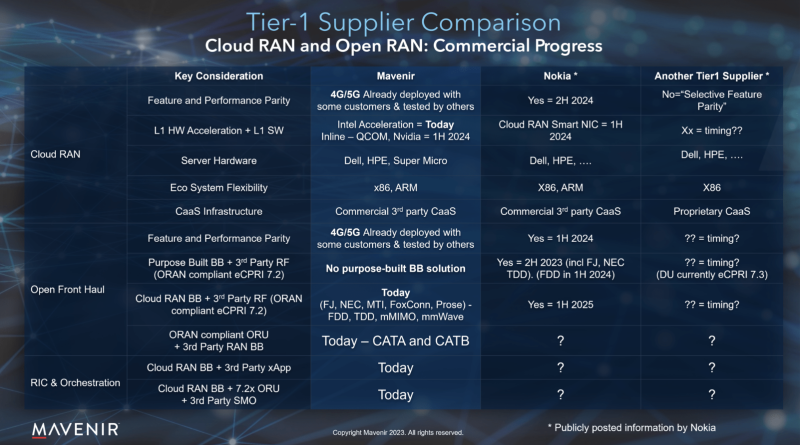Ericsson recently announced that it will introduce support for open fronthaul across its Cloud RAN and radio portfolios starting in 2024. And Fierce Wireless had a chance to catch up with Paul Challoner, VP of Network Product Solutions with Ericsson, at last week’s Cable Tech Expo show in Denver to ask him more about Ericsson’s open RAN strategy.
Challoner said Ericsson likes to segment the space into three topics when talking about open RAN: i) cloudification and virtualization of the RAN, ii) automation and iii) open fronthaul.
The open fronthaul interfaces connect the radio to the baseband. And the baseband may, or may not, be separated into a distributed unit (DU) and a centralized unit (CU). If the DU and CU are separated, then the open fronthaul interface connects the radio to the DU.

These fronthaul interfaces have been the area where new open RAN vendors have found the most fault with the legacy telecom vendors.
Radios from legacy vendors such as Ericsson, Nokia and Huawei account for the vast majority of radios deployed across telecom networks around world. And the proprietary fronthaul interfaces have kept telcos beholden to these vendors. So, open fronthaul interfaces have been a major focus of the O-RAN Alliance.
Things are finally loosening up, now.
Ericsson says that it has deployed over one million radios that are hardware-ready for the next generation of open fronthaul technology and, with its new radio platforms released this year, it has a complete open RAN-ready offering across its Massive MIMO and remote radio portfolios.
Last week, Challoner particularly called out Ericsson’s work within the O-RAN Alliance in regard to an uplink modification to open fronthaul for Massive MIMO radios. Ericsson was a leader at an O-RAN Alliance event in Osaka, Japan, in June 2023, to establish the uplink performance improvement (ULPI) specification, which is explained in detail in this Light Reading article.
Although one million Ericsson radios in the field are hardware-prepared for open fronthaul software upgrades, that doesn’t mean operators will flip a switch overnight.
Challoner said, “As operators need to add capacity in a new area or a new band, it gives them the opportunity to deploy.”
Stefan Pongratz, vice president with the Dell’Oro Group, cautioned that Ericsson’s news doesn’t necessarily imply that it’s going to open up its RAN platforms for mixing and matching among multiple vendors. “The first step is to have open fronthaul,” said Pongratz. “But there are different degrees in terms of openness.”
In fact, Pongratz said he no longer likes the term “open RAN.” These days he prefers to talk about “single-vendor RAN” and “multi-vendor RAN.”
But he thinks it’s good news that Ericsson announced its move toward open fronthaul interfaces.
“The biggest thing is the fact that the incumbent suppliers are now committing to open RAN,” said Pongratz. “We had always assumed the leading suppliers would be a big part of the movement. It’s going to be a big catalyst for the open RAN movement.”
And he said even if it doesn’t immediately cause more mixing and matching among vendors, the open interfaces ensure future freedom to operators.
Cloudification and automation
The second element of open RAN that Ericsson likes to talk about is cloudification and virtualization of the RAN. It’s important for open RAN to work in a cloud-based environment.
“vRAN is a step on the journey,” said Challoner. “The virtualized RAN is progressing well along with partners Intel and AMD. For cloud RAN you need server manufacturers like HPE and Dell, and you need cloud players from Red Hat, Wind River, etc. It takes an ecosystem for success.”
Finally, the third topic Ericsson talks about in terms of open RAN is automation — specifically the RAN intelligent controller (RIC). “Ericsson has a RIC platform,” said Challoner. “And we see good evolution in the rAPP, which is a programmable interface for the RAN.”
In the future all of the RAN modules like the DU, CU and radio unit (RU) will provide data and measurements, which will be funneled to the RIC. The RIC will then take all of those measurements and process them within xApps and rApps. The apps will then control or configure elements of the network.
An xAPP runs in near real time, while an rAPP runs a tiny bit slower.
Asked what some early use cases are for these apps, Challoner said there are some related to energy efficiency and some focused on moving loads around the network to operate it more efficiently.
Ericsson is currently focusing on rAPPs. Challoner said, “We believe most control of the RAN can be done in seconds rather than real time.”
Ericsson isn’t the only vendor talking about open RAN in terms of cloudification, open fronthaul and the RIC. Mavenir posted a blog recently where it said, “While traditional RAN vendors are planning for O-RAN compliant baseband and radio units in the future, Mavenir supports all of them today and on 2G, 4G and 5G technologies.”
And Mavenir created this chart, comparing itself to Nokia and “Another Tier 1 Supplier,” which we assume must be Ericsson.
